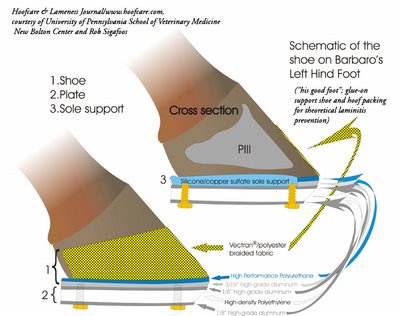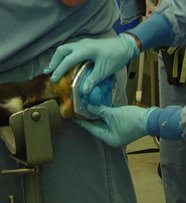Photos by Susan Hankin, JD, MPH
Many thanks to Upenn Chief of Farrier Services Rob Sigafoos for sharing with us the first official release of photos and information on the shoe designed for Barbaro’s “good” foot. The good foot must be supported in an effort to prevent what is called “support limb laminitis”, caused by over-stressing the good leg during recovery from an injury in the opposite limb.
While support limb laminitis is more of a risk in horses who injure the front legs, which bear more weight than the hind, there is still a risk of developing laminitis in the hind limb.
According to Rob, who granted Hoofcare & Lameness his first interview on the case today, Barbaro was laid down on the surgical table around noon on Sunday, after being admitted on Saturday following his injury in the Preakness Stakes in Baltimore, Maryland.
All the colt's race plates were pulled off by Rob and his feet were trimmed. Rob traced the left hind at this time, and went to work building a shoe to fit the tracing while Dr Dean Richardson moved the horse into the sterile surgical suite to begin surgery.
Later that night, when the operation was finally complete, Rob returned to the surgical suite and met up with Barbaro again when he was removed from the sterile setting and the cast was applied to his injured leg. Rob glued the shoe on the left hind (“the good foot”) at that time, while the horse was laying down. The horse was then lowered via hydraulic sling into the recovery pool, where he emerged safely from anesthesia.
The shoe is a double hospital-plate device. It is quite possible that blog viewers will not be able to read the fine lettering on the art that accompanies the official statement from the vet school about the device, so I will describe it to the best of my ability:
The bottom layer is what is called by farriers a hospital plate. It is a 1/8” thick sheet of aluminum, cut in the shape of the foot, and is held on with four bolts that are threaded into the two bottom layers of the device.
The “sandwich” layer is high-density polyethelene used as a spacer, followed by the second plate, also made from 1/8” high-grade aluminum, which attaches to the shoe, which is made from 3/16” high-grade aluminum, and is bonded to high-performance polyurethane, which is in turn bonded to Vectran/polyester braided fabric, which forms the “cuff” of the shoe. Thickened with adhesive, the Vectran becomes an artificial outer wall for most of the hoof and holds the shoe in place. A PMMA-type adhesive is used; in this case the commercial name is EquAcrylic.
The spacer plate (white polyethelene) is used to equalize the horse’s limbs, so that they will be the same length and increase the probability that the horse will easily shift weight from one leg to the other and bear weight normally while standing in the stall.
Rob’s secret weapon is the use of copper sulfate-impregnated silicon hoof packing. While no one is predicting that the horse will develop laminitis (according to Rob, the foot looked normal in conformation, with no visible evidence of past hoof disease), it is important to be pro-active. The hoof packing will keep the sole clean, in the event of laminitis.
The hospital plates can be unscrewed and removed to check the bottom of the foot. If the horse does develop laminitis, the sole and frog will be accessible for medication and treatment without removing the shoe.
“This copper sulfate silicon packing is the closest thing I have seen to a silver bullet in laminitis treatment,” Rob told me today. “In this case, of course, the use is prophylactic and we certainly hope that this horse does not develop laminitis.”
The wad of blue hoof packing will pop out of the foot once the hospital plate is removed. In addition to keeping the sole clean, the copper sulfate will toughen the sole as well. It will be carefully monitored.
Shoeing to prevent support-limb laminitis in orthopedics cases is often a “Catch 22” situation, according to Rob. If the horse does not get laminitis, the shoe will not get the credit, the horse will, for standing on both legs. If the horse does get laminitis, the shoe design will be blamed—-it should be have shorter, taller, more support, different configuration, etc.
Rob didn’t mention it, but the horse is probably also wearing support wraps on the good leg.
In closing, both Rob and New Bolton Center farrier Laura Florence remarked on the media frenzy and the outpouring of support from the public. Delivery trucks are bringing cases of apples and carrots, and a wall of get-well wishes lines the highway outside the campus.
Sigafoos shoes link (Sound Horse Technologies in Pennsylvania): http://www.soundhorse.com Copper sulfate silicon link: http://www.soundhorse.com/copper_sulfate.htm
Text and photos © 2006 Hoofcare Publishing. Text and photos posted on “The HoofBlog”, a casual news source for subscribers and friends of Hoofcare & Lameness: The Journal of Equine Foot Science. Learn more (and subscribe online using our secure server) at http://www.hoofcare.com or write to Hoofcare Publishing, 19 Harbor Loop, Gloucester MA 01930 USA. Tel USA 978 281 3222; Fax 978 283 8775, or email hoofblog@hoofcare.com
Note: this blog is an interactive web page. By clicking on the envelope icon at the bottom of an article, you can instantly email that article to a friend. By clicking on the word “comment” after a post, you can leave a message, which may be viewed by future blog readers who click on the same “comment”. Commenting may require registering with Blogger.com. You may also comment by emailing the author, Fran Jurga, at fran@hoofcare.com and your comment will be posted for you, technology willing.







